12 of the Best Rear Delt Exercises to Build Your Shoulders

Anatomy | Benefits | Exercises
Broad, well-defined shoulders are the mark of a commanding physique — but building this muscle group requires more than a frontal assault. If you want fully-developed shoulders, it’s essential to make rear delt exercises a regular part of your training.
“The rear deltoids are the unsung heroes of the upper body,” says personal trainer Amanda Dale, M.A., A.C.E.-C.P.T. They provide strength in rowing movements, help with stability in pressing movements, and are largely responsible for the lean, toned look of the mid-to-upper back, she adds.
Unfortunately, Dale says, the rear delts are often the weakest of the three heads comprising the deltoid. This is largely the consequence of a sedentary lifestyle, which, not coincidentally, often counts poor posture among its casualties. If you don’t address the muscular imbalance between the fronts and backs of your shoulders, you could end up with poor shoulder mobility and mechanics — and potentially set yourself up for a shoulder injury in the process.
To get you started, we’ve rounded up 12 of the best rear delt exercises to incorporate into your routine. But first, let’s brush up on our anatomy.
Deltoid Anatomy
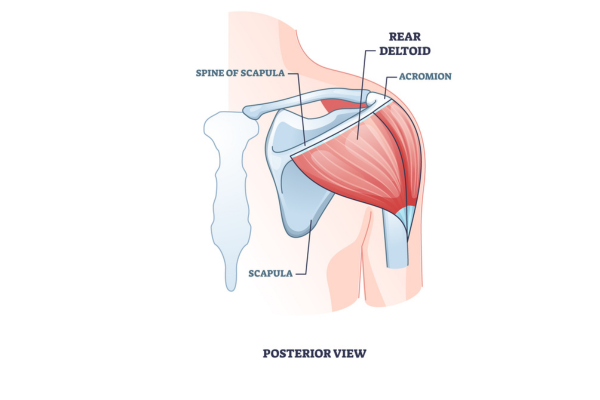
Your rear delts are referred to physiologically as the posterior head of the deltoid, joining the anterior and lateral heads to form the full deltoid muscle. The three heads originate along the scapula (shoulder blade) and collarbone, and connect midway down your humerus (upper arm).
The rear delts join the shoulders and back, and are technically part of your posterior chain. This means you can effectively hit your rear delts with both shoulder and back exercises.
Benefits of Training Rear Delts
Apart from building more rounded shoulders, training your rear delts regularly can impart the following benefits.
Prevents muscle imbalances
Of the three deltoid muscles, the rear delts are often the most neglected. Your front or anterior delts are generally well-trained thanks to pressing movements like push-ups, bench presses, and overhead presses, while the side or lateral delts get love from lateral raises.
By focusing on rear delt training, you can avoid imbalances among your deltoid heads and contribute to overall strength and growth.
Improves posture and shoulder function
One reason for the forward head posture that many of us unconsciously assume throughout the day is underdeveloped rear delts. Over time, this rounded back position can lead to pain and tightness in your neck and back as well as poor shoulder joint function.
Keeping a few rear delt exercises in rotation can help strengthen the muscles responsible for keeping your upper back straight and help you reach your arms overhead more comfortably, allowing you to potentially press more weight.
Best Rear Delt Exercises
Choose among these 12 rear delt exercises to perform on a weekly basis to increase strength and size.
1. Dumbbell reverse fly
Benefits: This move will strengthen the rear deltoid, rhomboids, and middle fibers of the trapezius (the ones that aid in scapular retraction). Plus, all you need is a light pair of dumbbells.
Equipment: Dumbbells (2)
- Stand with your feet shoulder-width apart holding a dumbbell in each hand.
- Push your hips back and hinge forward at the waist until your torso is almost parallel with the floor. Let your arms hang straight down, palms facing each other.
- Keeping your back flat and abs engaged, maintain a slight bend in your elbows as you raise your arms out to the sides until they reach shoulder level. Squeeze your shoulder blades together at the top of the movement.
- Slowly reverse the move to return the weights to the starting position, and repeat for reps.
2. Resistance band face pull
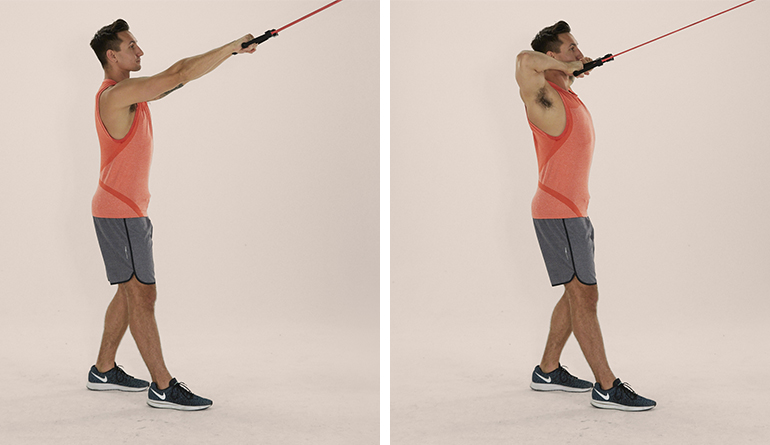
Benefits: The face pull will work your rear delts and upper back muscles while also strengthening your rotator cuff muscles, and the resistance bend helps you keep tension during the entire range of motion of the exercise.
Equipment: Resistance band
- Anchor a resistance band to a stable point several inches above your head.
- Facing the anchor point, grab the band with an overhand grip, keeping your hands about six inches apart.
- Step back from the anchor point with your arms extended in front of you until you feel tension in the band.
- Keeping your back straight and elbows high, pull the band toward your face, stopping once the band approaches your nose.
- Slowly reverse the move to return to the starting position, and repeat for reps.
3. Single-arm dumbbell row
Benefits: Because you’re bracing your body on a bench, you can load this exercise more than a regular two-armed row. Just be sure to avoid using momentum to jerk the weight up, and instead control the movement on the way up and on the way down with your lats and rear delts.
Equipment: Dumbbell (1)
- Holding a dumbbell in your right hand, place your other hand on a bench in front of you. Step your right leg back keeping it straight, and bend your left leg slightly. Lean your chest forward, keeping your back flat.
- Drive your elbow up, bringing the dumbbell to your ribcage.
- Release your arm down and repeat.
- Do equal reps on both sides.
4. Inverted row
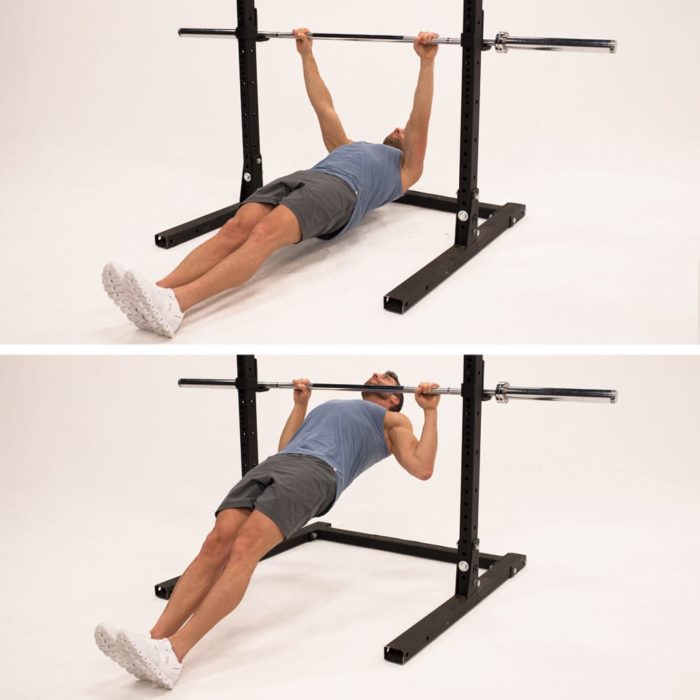
Benefits: The inverted row is a great exercise for your rear delts and back, especially if you’re a beginner. You can easily modify it by stepping backwards, as the more horizontal you are, the harder the exercise is. Plus, it’s an efficient pull-up progression.
Equipment: Barbell or flat bar around waist height
- Secure a bar in a rack at waist height, and lie on the floor underneath it.
- Using an overhand grip, grab the bar with both hands slightly wider than shoulder-width, and hang with your arms fully extended. Your shoulders should be directly below your hands, and your feet should be hip-width apart. This is the starting position.
- Keeping your body straight from head to heels, pull your chest up to the bar, and pause briefly at the top of the movement.
- Slowly lower yourself until your arms are fully extended, and repeat for reps.
5. Reverse fly on bench
Benefits: Sitting on a bench — as opposed to standing up — relieves your core of much of the work needed to stabilize your body, allowing you to focus entirely on the rear delts, traps, and rhomboids.
Equipment: Dumbbells (2) and bench or other stable surface
- Holding a set of dumbbells, sit on a bench or stability ball. With your feet flat on the ground, hinge at the waist to lean forward slightly, and bring your dumbbells behind your calves, palms facing each other.
- With a slight bend at the elbow, raise your arms outward and squeeze your shoulder blades, keeping your palms facing the floor.
- Release your arms slowly and repeat.
6. Dumbbell bent-over row
Benefits: The bent-over row is one of the best exercises you can do for your back. It hits nearly every muscle in your upper and middle back while working your rear deltoids and requiring you to engage your core to maintain stability.
Equipment: Dumbbells (2)
- Stand with your feet hip-width apart holding a dumbbell in each hand.
- Engage your core, push your hips back, and hinge forward at the waist until your torso is almost parallel with the floor. Let your arms hang straight down, palms facing each other.
- Keeping your back flat, squeeze your shoulder blades together as you pull the weights up to your sides.
- Pause, then lower the weights to the starting position. Repeat for reps.
7. Pterodactyl fly
Benefits: If you want your rear delt exercises to perform double (or triple!) duty, the pterodactyl fly will challenge your balance, stability, and core — all while strengthening and sculpting your posterior delts.
Equipment: Dumbbells (2)
- Holding two light dumbbells at your sides, assume a long, runner’s lunge position, with your stronger leg forward, torso leaning forward, and forming a straight line from your back leg to your head. Keep your back leg straight.
- Keeping your torso still and the back of the hands facing the ceiling, slowly raise the dumbbells directly out to the sides until they are parallel to the floor, squeezing your shoulder blades together.
- Lower the dumbbells to the sides of your ankle and repeat.
8. Chest-supported dumbbell row
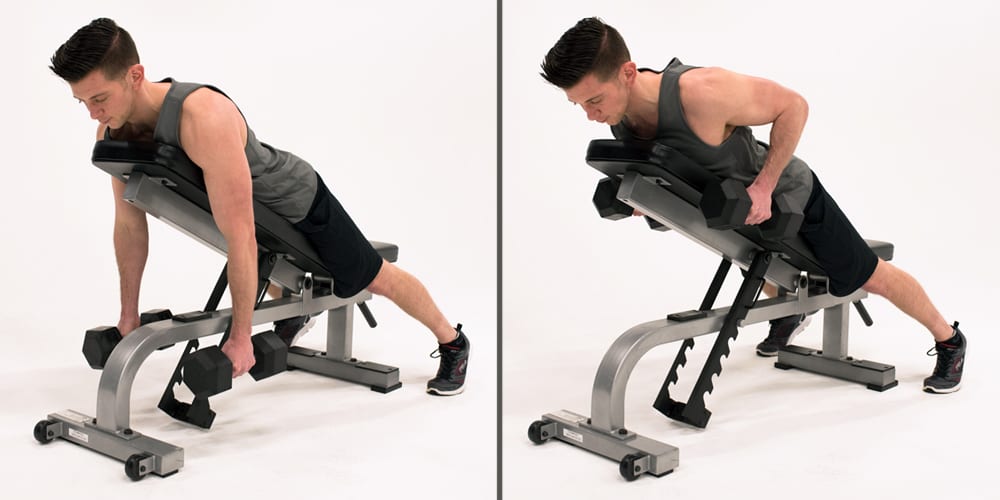
Benefits: As with the one-arm row, the added stability in the chest-supported row helps you lift heavier weights compared to the bent-over row.
Equipment: Dumbbells (2) and bench
- Set an incline bench at 45 degrees.
- Grab a pair of dumbbells, and approach the bench with your chest toward the angled pad, then lean onto it. Plant your feet firmly on the floor, and let your arms hang straight down, palms facing each other. This is the starting position.
- Squeeze your shoulder blades together and drive your elbows toward the ceiling, bringing the dumbbells to your ribcage.
- Slowly reverse the move, and repeat for reps.
9. Post delt fly with resistance bands
Benefits: The resistance band is what makes this exercise so effective; it provides constant tension during the entire movement and makes it easy to change the level of resistance.
Equipment: Resistance band
- Hold the handles of a resistance band and assume a shoulder width stance, using both feet to stand on the center of the band to secure it.
- Exchange handles between your two hands so that the bands cross.
- Bend your knees slightly and hinge at your hips until your torso is almost parallel to the floor and your back is flat. (If necessary, spread your feet wider to create more tension on the band.)
- Keeping your torso still, raise the handles as far as possible directly out to your sides, with the back of your hands facing the ceiling.
- Lower the handles fully, and repeat.
10. Dumbbell Y-T-I raise
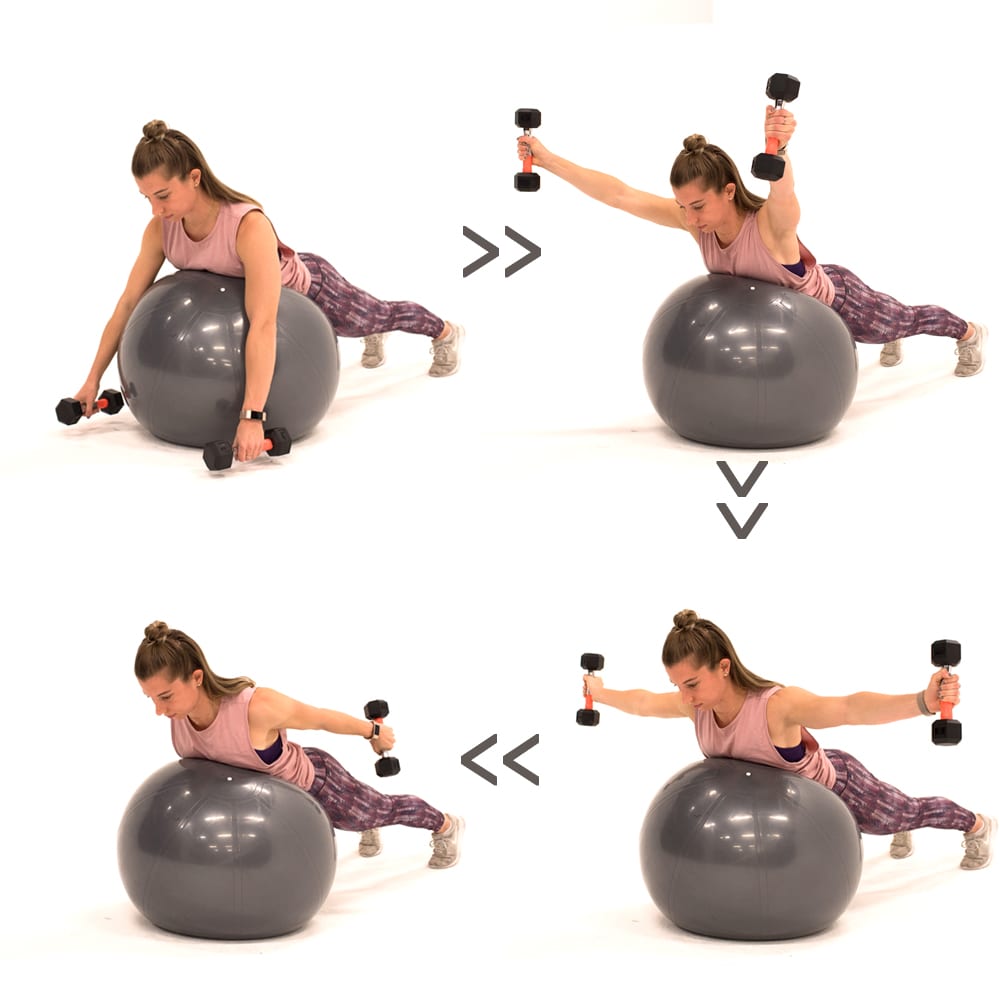
Benefits: The Y-T-I raise helps unlock serious shoulder mobility while building strength in nearly every part of your back.
Equipment: Dumbbells (2) and stability ball
- Lie face-down on a stability ball or bench holding a dumbbell in each hand. Let your arms hang straight toward the floor, palms facing each other.
- Keeping your head neutral, raise both arms at 45 degrees to form a “Y” shape. Pause briefly. Then, lower the weights back to the starting position.
- Lift the weights again, this time straight out to your sides to form a “T” shape, palms facing down. Pause briefly at the top of the movement before lowering the weights.
- Finally, lift the weights by extending them straight behind you to create an “I” shape, palms facing each other. Hold briefly and lower the weights.
- Repeat the entire sequence for the desired number of reps.
11. Cable rear delt fly
Benefits: Along with targeting the rear delts, the cable rear delt fly also trains external shoulder rotation (rotating your upper arms out and away from the center line of your body), a key function of the rear delts.
Equipment: Dual cable machine
- Select a light weight on both stacks of a dual cable machine, and slide the pulleys to around shoulder height.
- Face the machine and take hold of the cable for the stack on the right in your left hand and the cable for the stack on the left in your right hand (the cables will be crossed in front of you).
- Still facing the machine, assume a kneeling position — on a pad if necessary — about two feet behind the front stacks of the cable machine.
- Reach your arms directly forward and upward in front of you, about 45 degrees to the floor. This is your starting position.
- Keeping your arms slightly bent, slowly draw the cables in wide arcs down and behind you, squeezing your rear deltoids as hard as possible in the end position (think of pushing the pinkie-sides of your hands down and outward).
- Slowly reverse the movement, return to the starting position, and repeat for reps.
12. Stability ball cobra pose
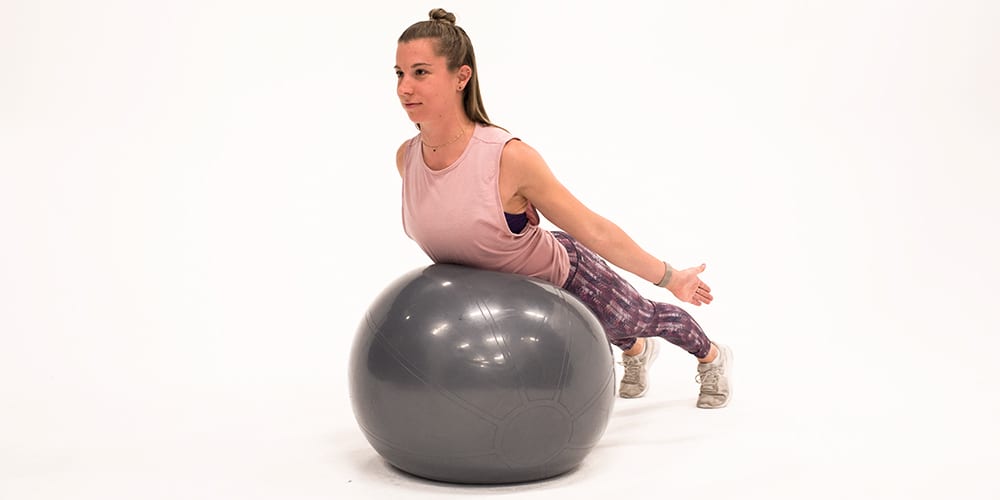
Benefits: Although it looks simple, this rear delt exercise will challenge your core stability and shoulder mobility. Only when you’re comfortable with the movement, though, should you add weights to it.
Equipment: Stability ball
- Lie face-down with your abdomen on a stability ball, and your legs extended straight behind you. Flex your feet to support your weight on your toes.
- Keeping your gaze toward the floor, extend both arms in front of you to form a “Y” shape. Your palms should face the floor.
- Sweep both arms out to the sides and bring them behind you as you lift your chest and bring your gaze forward. End with both arms behind you, thumb pointing to the ceiling.
- Reverse the movement to return to the starting position, and repeat. Add weights to intensify the move.
